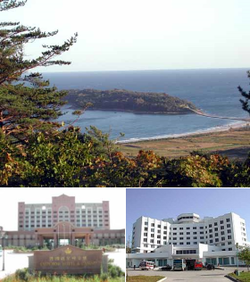Rason
라선시 | |
|---|---|
| 라선특별시 · Rason Special City | |
| Korean transcription(s) | |
| • Chosŏn'gŭl | 라선특별시 |
| • Hancha | 羅先特別市 |
| • McCune-Reischauer | Rasŏn T'ŭkpyŏlsi |
| • Revised Romanization | Raseon Teukbyeolsi |
 Bipaseom Island (top), Imperial Hotel and Casino (bottom left), Rason Hotel (bottom right) | |
 | |
 | |
| Country | |
| Region | Kwanbuk |
| Government | |
| • Party Committee Chairman | Rim Kyong-man[1] (WPK) |
| • People's Committee Chairman | Cho Chong-ho[1] |
| Area | |
• Total | 746 km2 (288 sq mi) |
| Elevation | 27 m (89 ft) |
| Population (2019)[2] | |
• Total | 205,000 |
| • Density | 275/km2 (710/sq mi) |
| • Dialect | Hamgyŏng |
| Time zone | UTC+9 (Pyongyang Time) |
| ISO Code | KP-13 |
Rason (formerly Rajin-Sŏnbong; Korean pronunciation: [ɾa.sʌ̹n, ɾa.dʑin.sʰʌ̹n.boŋ]) is a North Korean special city and ice-free port[3] in the Sea of Japan in the North Pacific Ocean on the northeast tip of North Korea. It is in the Kwanbuk region and location of the Rason Special Economic Zone.
In South Korean pronunciation, the initial "R" of the name is pronounced as "N", (나선, Naseon) as per standard Korean phonology. In 2000, the name was shortened from "Rajin-Sŏnbong" to "Rason". During the 1930s, the Japanese called it Rashin; at that time, it was an important port at the end of a railroad line. It fell under the control of the Red Army on 14 August 1945.
Before 1991, Rason was used by the Soviet Union as an alternative warm-water port in case Vladivostok was unavailable.[4] The Soviet naval facilities were built starting in 1979.[5] From 1993 to 2004, it was administered separately from North Hamgyŏng as the directly governed city (chikhalsi) of Rason. Prior to 1993 and from 2004 to 2009, the city had been part of the North Hamgyŏng Province. Since 2010, the city is a "special city", again breaking from provincial control, but different from its older designation as a directly governed city.[6] What this means in practice is unclear.
Rason borders Hunchun county in Jilin province of China and Khasansky District in Primorsky Krai of Russia.[3] China is making investments in the port as it gives it access to the Sea of Japan.[3][7] In July 2011, the Democratic People's Republic of Korea (DPRK) gave a green light for China's domestic trade cargo to be shipped via its port of Rajin from northeast to east China.[8] Coal is shipped from nearby Chinese mines to Shanghai.[3] A casino by the sea caters to Chinese visitors.[9]

- ^ a b "Organizational Chart of North Korean Leadership" (PDF). Seoul: Political and Military Analysis Division, Intelligence and Analysis Bureau; Ministry of Unification. January 2018. Retrieved 17 October 2018.
- ^ "朝鲜罗先市" (in Chinese). 18 October 2019. Retrieved 25 May 2020.
- ^ a b c d Andray Abrahamian (September 2011). "Report on Rason Special Economic Zone" (PDF). Choson Exchange. Archived from the original (PDF) on 17 April 2012. Retrieved 9 December 2012.
- ^ Robinson, Thomas W. (January 1982). "The Soviet Union and Asia in 1981". Asian Survey. A Survey of Asia in 1981: Part I. 22 (1): 20. doi:10.2307/2643707. JSTOR 2643707.
- ^ Hodson, H. V.; Rose, Bishakha, eds. (1980). The Annual Register of World Events 1979. 221. UK: Longmans Group Limited. pp. 104, 314. ISBN 0-8103-2023-1.
- ^ "Rasun Becomes Special City". Daily NK. 5 January 2010. Archived from the original on 22 March 2012.
- ^ "Strategic Implications of China's Access to the Rajin Port". The Jamestown Foundation. 18 March 2010. Archived from the original on 28 February 2011.
- ^ "DPRK allows China domestic trade cargo to ship via its port". China Daily. 4 July 2011. Archived from the original on 19 August 2011.
- ^ Wong, Edward (12 October 2011). "Tending a Small Patch of Capitalism in North Korea". The New York Times. Archived from the original on 13 October 2011. Retrieved 13 October 2011.